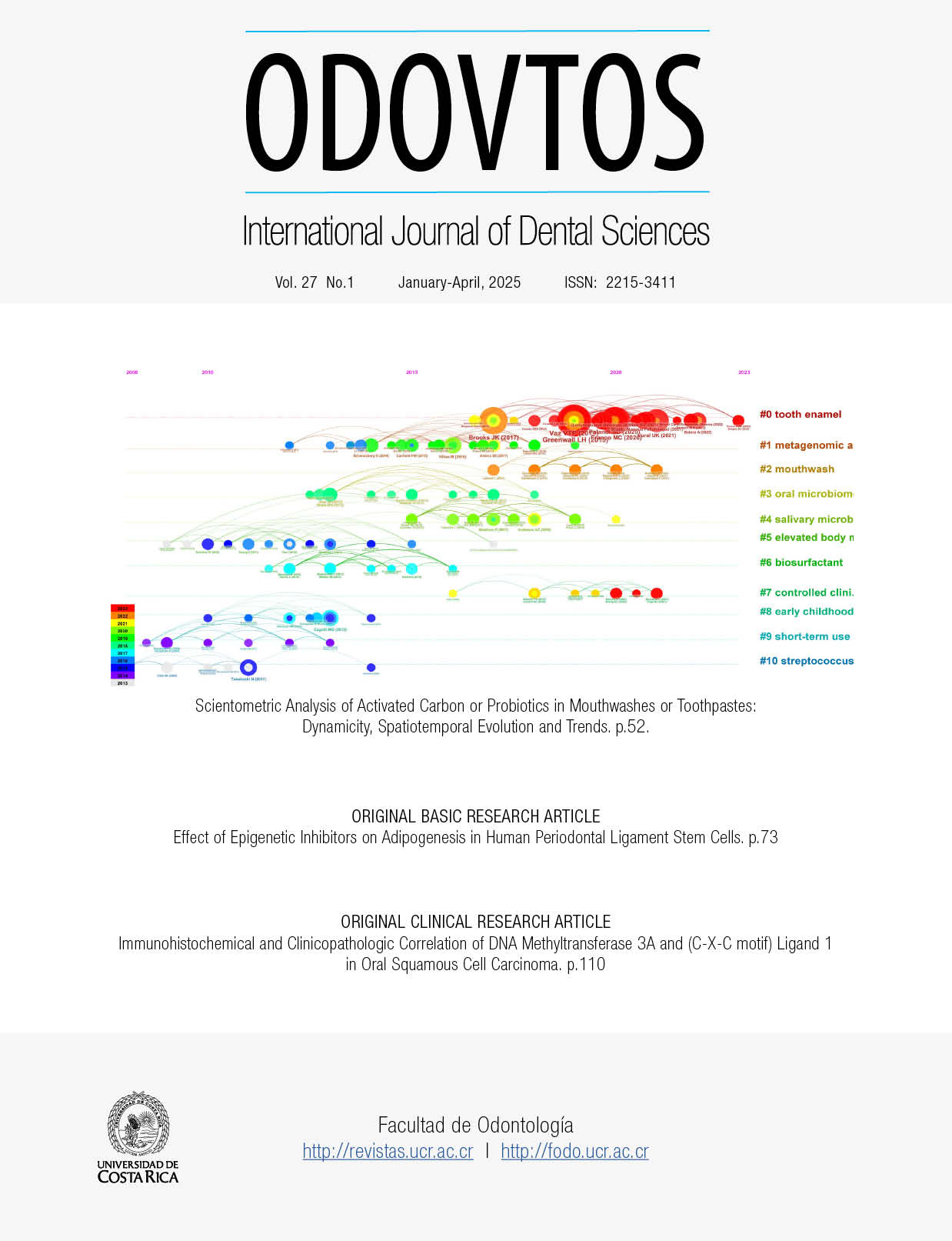Resumen
El objetivo de esta revisión fue investigar la posibilidad de alinear los datos de un escáner intraoral tridimensional con los datos de dispositivos móviles faciales, así como comparar la efectividad de la búsqueda basada en Inteligencia Artificial con los métodos de búsqueda manual. Esta investigación se adhirió a las directrices PRISMA con el objetivo de responder a la pregunta PICO: "¿Las tecnologías tridimensionales faciales e intraorales son compatibles y clínicamente aplicables en la rehabilitación oral?". Se empleó una estrategia de búsqueda incorporando palabras clave específicas ("dental", "intraoral", "fotogrametría", "escáner", "tridimensional", "estereofotogrametría", "scan", "articuladores virtuales", " facebow", "rostro", "facial") dentro de múltiples bases de datos (Pubmed, BVS y Scielo), incluída la inteligencia artificial (Scite.ai). De los 7128 artículos identificados inicialmente, se incluyeron 4 artículos de búsqueda manual pero no se agregó ningún artículo del sitio web de inteligencia artificial. Entre los más utilizados: en los escáneres intraorales se encontraban los TRIOS (3shape) (n=2) y para imágenes faciales los teléfonos móviles de Apple Inc. (n=2). El software reportado con mayor frecuencia fue Bellus3D (Bellus3D Inc.), con especial énfasis en el software de georreferenciación. Se observaron varios puntos en común, incluido el requisito de un espacio de 30cm durante el escaneo extraoral con teléfono celular, la necesidad de capturas múltiples y la inclusión de puntos de referencia y/o escaneos periorales y nasales. La búsqueda manual sigue siendo el estándar de oro para la búsqueda de datos científicos. Tanto la estereofotogrametría como el escaneo de dispositivos móviles se pueden utilizar para el escaneo facial y los archivos se pueden integrar mediante el uso de software táctico de georreferenciación.
Citas
Khurshid Z. Digital Dentistry: Transformation of Oral Health and Dental Education with Technology. Eur J Dent 2023; 17: 943-4
Perez-Giugovaz M.G., Park S.H., Revilla-Leon M. Three-dimensional virtual representation by superimposing facial and intraoral digital scans with an additively manufactured intraoral scan body. J Prosthet Dent 2020; 126: 459
Kordaß B., Gärtner C., Söhnel A., Bisler A., Voß G., Bockholt U., Seipel S., et al. The virtual articulator in dentistry: concept and development. Dent Clin 2002; 46 (3): 493-506
de Caxias F.P., Dos Santos D.M., Bannwart L.C., de Moraes Melo Neto C.L., Goiato M.C. Classification, history, and future prospects of maxillofacial prosthesis. Int J Dent 2019; 1: 8657619
Ye H., Ye J., Wang S., Wang Z., Geng J., Wang Y., Zhou Y. Comparison of the accuracy (trueness and precision) of virtual dentofacial patients digitized by three different methods based on 3D facial and dental images. J Prosthet Dent 2022; 3913 (22): 99-3. https://doi.org/10.1016/j.prosdent.2022.01.035
Mangano F., Mangano C., Margiani B., Admakin O. Combining Intraoral and Face Scans for the Design and Fabrication of Computer-Assisted Design/Computer-Assisted Manufacturing (CAD/CAM) Polyether-Ether-Ketone (PEEK) Implant-Supported Bars for Maxillary Overdentures. Scanning 2019; 2019: 1-14. https://doi.org/10.1155/2019/4274715
Alshadidi A.A.F., Alshahrani A.A., Aldosari L.I.N., Chaturvedi S., Saini R.S., Hassan S.A.B., et al. Investigation on the application of artificial intelligence in prosthodontics. Appl Sci 2023; 13 (8): 5004
Page M.J., McKenzie J.E., Bossuyt P.M., Boutron I., Hoffmann T.C., Mulrow C.D., et al. The PRISMA 2020 statement: An updated guideline for reporting systematic reviews. J Clin Epidemiol 2021; 134: 178-89
Mai H., Lee D.H. The Effect of Perioral Scan and Artificial Skin Markers on the Accuracy of Virtual Dentofacial Integration: Stereophotogrammetry Versus Smartphone Three-Dimensional Face-Scanning. Int J Environ Res Public Health 2021; 18 (1):229. https://doi.org/10.3390/ijerph18010229
Li J., Att W., Chen Z., Lepidi L., Wang H.L., Joda T. Prosthetic articulator-based implant rehabilitation virtual patient: A technique bridging implant surgery and reconstructive dentistry. J Prosthet Dent 2023; 130 (1): 8-13
Jreige C.S., Kimura R.N., Segundo Â.R.T.C., Coachman C., Sesma N. Esthetic treatment planning with digital animation of the smile dynamics: A technique to create a 4-dimensional virtual patient. J Prosthet Dent 2022; 128 (2): 130-8
Hong S.J., Noh K. Setting the sagittal condylar inclination on a virtual articulator by using a facial and intraoral scan of the protrusive interocclusal position: A dental technique. J Prosthet Dent 2021; 125 (3): 392-5.
Sun A., Yang Y., Gao H., Lin W.S., Chen L., Tan J. Integrating facial and intraoral scans for digital esthetic and occlusal design: a technical report. J Prosthet Dent 2021; 30 (8): 729-33.
Conejo J., Dayo A.F., Syed A.Z., Mupparapu M. The digital clone: intraoral scanning, face scans and cone beam computed tomography integration for diagnosis and treatment planning. Dental Clinics 2021; 65 (3): 529-53. https://doi.org/10.1016/j.cden.2021.02.011
Bechtold T.E., Goz T.G., Schaupp E., Koss B., Godt A., Reinert S., Berneburg M. Integration of a maxillary model into facial surface stereophotogrammetry. J Orofac Orthop 2012; 73 (2): 126-37.
Gallardo Y.N., Salazar-Gamarra R., Bohner L., De Oliveira J.I., Dib L.L., Sesma N. Evaluation of the 3D error of 2 face-scanning systems: An in vitro analysis. J Prosthet Dent 2023; 129 (4): 630-636
Ritschl L.M., Wolff K.D., Erben P., Grill F.D. Simultaneous, radiation-free registration of the dentoalveolar position and the face by combining 3D photography with a portable scanner and impression-taking. Head Face Med 2019; 15 (1): 1-9
Andrews J., Alwafi A., Bichu Y.M., Pliska B.T., Mostafa N., Zou B. Validation of three-dimensional facial imaging captured with smartphone-based photogrammetry application in comparison to stereophotogrammetry system. Heliyon 2023; 9 (5). https://doi.org/10.1016/j.heliyon.2023.e15834
##plugins.facebook.comentarios##

Esta obra está bajo una licencia internacional Creative Commons Atribución-NoComercial-CompartirIgual 4.0.
Derechos de autor 2024 Juliana Lujan Brunetto, Manuel Martin Adriazola Ique, Clovis Lamartine de Moraes Melo Neto, Victor Perinazzo Sachi, Daniela Micheline dos Santos, Marcelo Coelho Goiato


